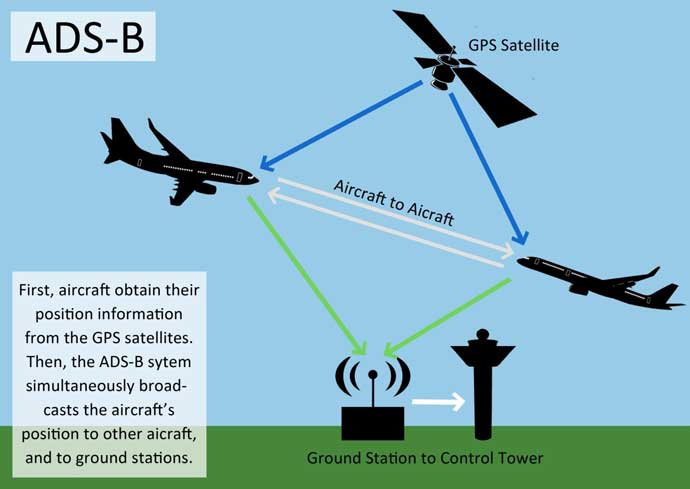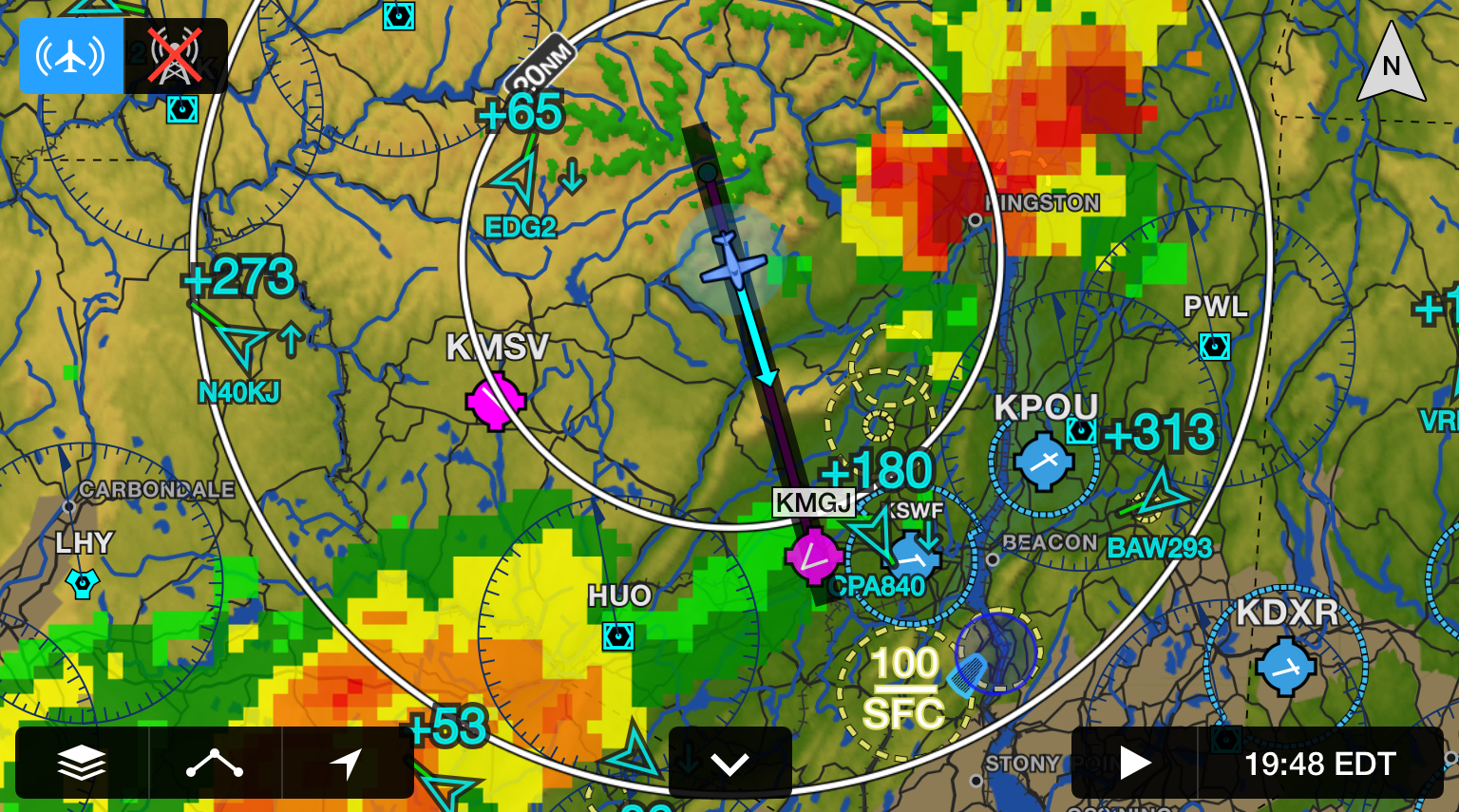
It is part of the Federal Aviation Administration’s (FAA) NextGen program to modernize the United States’ air transportation. First of all, it is necessary to explain what each word in ADS-B means:
A (Automatic) : the system operates without any external input.
D (Dependent) : the system gathers data from the aircraft’s onboard equipment.
S (Surveillance) : the system helps to observe the position and identification of aircrafts.
B (Broadcast) : the information is transmitted to air traffic controllers (ATC) and other aircrafts.
There are two types of ADS-B: ADS-B Out and ADS-B In. An aircraft’s information, which consists of its identification (model and registration), location, direction of flight, altitude, vertical and ground speed are transmitted from the aircraft using ADS-B Out. ATC, ground stations, and other aircrafts in the vicinity then receive this information using ADS-B In.

An ADS-B system is made up of two main components: a position source and a datalink. At present, Global Positioning System (GPS) is the only approved position source that fulfils all the criteria stipulated in the regulations. For those of you who are interested, you can look up 14 CFR § 91.227 and EASA AMC 20-24 for more details.
Meanwhile, there are two options for the datalink equipment: a Mode S transponder based unit with an extended squitter which uses the 1090 MHz frequency, or a Universal Access Transceiver (UAT) unit which uses the 978 MHz frequency. The decision as to which datalink equipment to use depends on the type of operation.
For large transport aircrafts flying internationally and/or above 18,000 feet, the Mode S unit is required. For general aviation aircraft flying below 18,000 feet, either the Mode S or the simpler, more affordable UAT is acceptable.
ADS-B is developed to replace the existing radar system as a means to monitor locations of aircrafts. The most important advantage that ADS-B has over radar is the use of GPS satellites, rather than purely ground-based radar stations. As most of us already know, a radar station sends out an electromagnetic pulse and receives the pulse reflected from the aircraft to determine its position. This radar pulse is often cluttered by terrain and bad weather, resulting in poor precision and limited ‘line of sight’.
Combined with the size and complication of setting up a rotating radar dish, aircraft tracking becomes more difficult in less accessible areas, such as the mountains and the oceans. With ADS-B, each individual aircraft obtains its position directly from the GPS satellites, which is unaffected by geographical and meteorological conditions. The ADS-B ground station is therefore reduced to just a receiver, making it far cheaper and easier to build.
Also, unlike the ground radar signal which is transmitted in a circular sweeping motion and has an interval between 5 to 12 seconds, the ADS-B signal is transmitted every second, resulting in an almost real-time tracking of the aircraft velocity and position. This greatly helps the ATC in locating all the nearby aircrafts quickly, accurately, and reliably.

Another benefit derived from ADS-B is a tighter spacing between aircrafts. Since aircraft positions are reported every second and with greater accuracy, their movements become easier to track and anticipate. Consequently, air traffic controllers would have more confidence in managing the airspace and reducing the separation between each aircrafts. This leads to faster turnaround times and more efficient airspace utilization. More aircrafts can now be flying within the same airspace with less risk of collision.
In the United States, the FAA has issued a final rule dated May 27, 2010, making ADS-B Out installation compulsory for aircrafts flying in most of the controlled airspace as defined in the 14 CFR § 91.225 by January 1, 2020. Across the Atlantic, the European Aviation Safety Agency (EASA) requires that ADS-B Out is fitted on aircrafts by June 7, 2020.
For other countries and jurisdictions, it is best to check with the local civil aviation authority directly, as they might have different deadlines. On the other hand, ADS-B In is currently still optional and not obligated by law. Nevertheless, ADS-B In can significantly improve pilots’ situational awareness and decision-making.
ADS-B In gives pilots access to Traffic Information Service-Broadcast (TIS-B) and Flight Information Service-Broadcast (FIS-B). TIS-B allows an aircraft equipped with ADS-B In to identify the position and speed of all other aircrafts within 15 nautical mile radius and 3,500 feet above and below itself. FIS-B provides graphical weather and aeronautical data, albeit on the 978 MHz frequency only, in order to avoid crowding the 1090 MHz frequency. Both services are provided free of charge by the FAA.
To maximize the benefits, it is possible, although certainly more expensive, for an aircraft to have dual ADS-B In, receiving information on both 1090 MHz and 978 MHz frequencies.

As of January 2018, major avionics manufacturers such as ACSS, Garmin, Honeywell, and Rockwell-Collins, are already selling FAA-approved ADS-B Out equipment. ACSS and Rockwell-Collins seem to target the commercial airlines (Boeing and Airbus airplanes) market, whereas Garmin and Honeywell are focusing on the business jets and turboprops. Due to various cockpit configurations and system interfaces, there is no universal solution.
Operators are advised to contact the manufacturers to avoid compatibility issues. Different manufacturers mean different software as well, so for pilots with multiple type ratings who frequently switched aircrafts, it is essential to always refer to the manufacturer’s operating manual before flight.

Just like any other new piece of technology, early adopters of ADS-B have reported problems, with close to 20% of all cases being attributed to wrong ICAO code. This is because installing the ADS-B is less about connecting wires and equipment, but more about programming and testing.
A single typographical error in the 24-bit ICAO code would result in one aircraft being displayed as two superimposed aircrafts with different identifications on the ADS-B In display.
If the maintenance shop where you install your ADS-B does not have a ground testing tool, then you need to fly in an ADS-B-required airspace and request a performance report from the FAA. Any errors will be highlighted in the report, typically generated within 30 minutes after landing, and then you can return to the maintenance shop for rectifications as necessary.